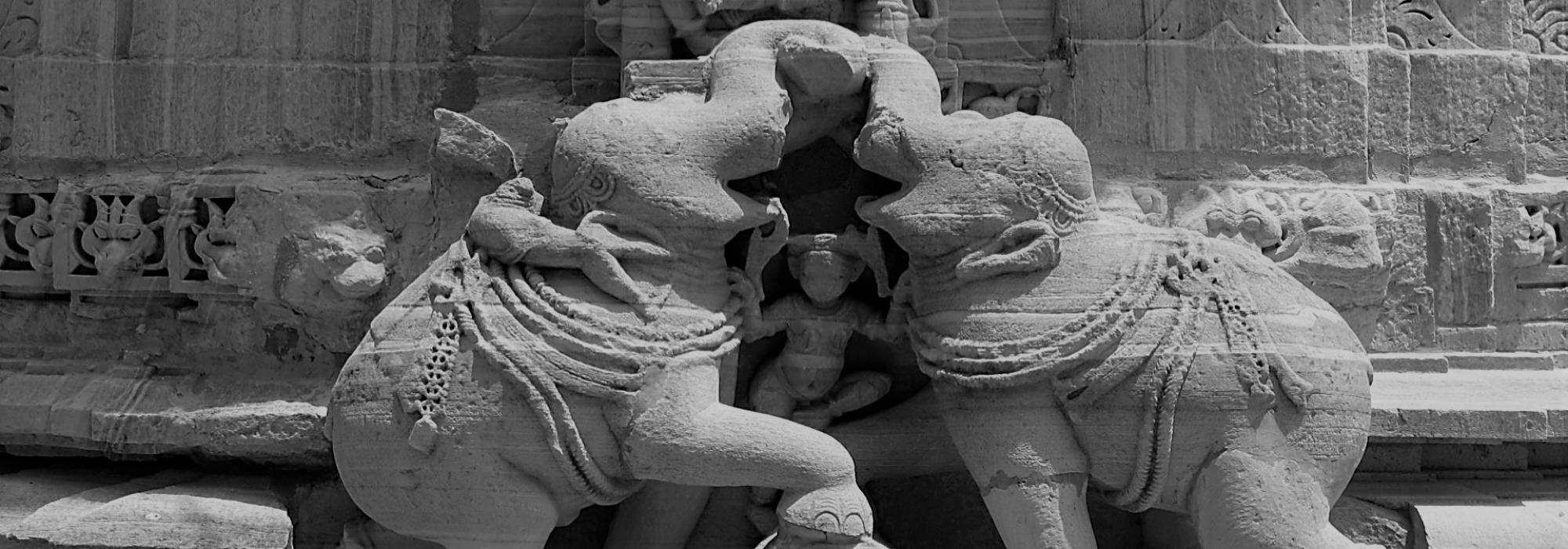“Sun arose in the West and moon in East”:
“धातर्मेरुमहीध्रलङ्घनधिया विन्ध्याद्रिणा सर्वतो
व्याप्तं व्योमतलं दिवेति च निशेत्यस्तं प्रतीतिर्गता”।
दूतेनैवमभाषि “सत्यमुत नो” “सत्यं, गते वासरे
प्रातः पश्चिमपर्वते दिनमणिः पूर्वाचले चन्द्रमाः”॥[1]
“O Creator, ambitious to surpass the divine mount Meru, this wretched Vindhya is growing taller by the second, eclipsing the entire sky. We have lost the distinction between day and night.” When a messenger reported so, Brahma enquired, “Is this true?” [The messenger replied] “yes, this is indeed the havoc! Just yesterday Sun arose in the West and moon in East.”
The solution is based on the well-known mythological story of Vindhya outgrowing other mountains. Sanskrit literary tradition assumes that sun and moon revolve around Meru, a mythical mountain. With Vindhya overtaking its height, the two luminous celestial bodies were thrown off their orbits.
“A girl’s son became her brother”:
न हि सन्ततिस्तु नरकार्णवापहे-
त्यतिदुःखमात्मपितरं निरीक्ष्य सा।
तनया ददौ स्वतनयं ततस्त्वहो
अनुजो बभूव तनुजोऽपि योषितः॥[2]
A grief-stricken father lamented, “I am doomed without male progeny!” His compassionate daughter offered him her son. So, a girl’s son became her brother.
This stems from the concept of dattaka that is well known in Dharma-śāstra.
“A fly gives birth to a camel in the nook of a sesame husk”:
शिशुरपि महनीयस्तद्बलश्रीविशेष-
श्चतुरचतुरमूर्तिर्दिव्यभाग्यैककीर्तिः।
शकटमसुरमुग्रं तं जघानेति तद्व-
त्तिलपुटतनुकोणे मक्षिकोऽष्ट्रं प्रसूते॥[3]
Even as a kid, Kṛṣṇa was uniquely powerful. He vanquished the mighty demon Śakaṭa and gained unparalleled fame. By the same logic, a fly gives birth to a camel in the nook of a sesame husk.
The poet has all the artistic liberty to make sense of the challenge in the way he pleases. His solution, however, must be charming; the element of wonder should never be compromised. The poet here has not taken the challenge literally. He has given an account of baby Kṛṣṇa slaying demons and thereby fashioned a logic that renders intelligible the impossible situation portrayed in the challenge. As it stands, the verse has a few words that do not directly bolster the context. It could have been composed with better, more powerful words.
The same method is employed to solve the next challenge, “rising sun went down in the ocean”:
व्यूहे महोग्रबलगर्वितवाहिनीनां
वीरावतारविभवप्रभवोऽद्वितीयः।
शक्रात्मजप्रियसुतो निहतश्छलेन
बालारुणस्तु निममज्ज पयोधिमध्ये॥[4]
Caught in the maze of expansive armies surcharged with the pride of ferocious strength, Abhimanyu, the embodiment of courage, Arjuna’s beloved son, was mercilessly murdered with deceit. Indeed, rising sun went down in the ocean.
“Ghee solidifies in fire”:
एलादिचूर्णघनसारसुगन्धपूर्णं
सच्छर्करासरलपाकविशेषयुक्तम्।
यावन्मितं चणकपिष्टविमिश्रमद्धा
हैयङ्गवीनमनले कठिनं बभूव॥[5]
Mysore Pak, the sweet dish, is made with just the right mix of camphor and cardamom soaked in a nice dose of sugar syrup along with the flour of Bengal gram. While making it, fresh ghee solidifies in fire.
The poet has employed a novel idea drawn from cookery, which has made this verse beautiful.
“Cow dung emanates a heady fragrance”:
कमलविपिनकान्तस्यात्मजाकूलकुञ्जे
चटुलकपटगोपः पालयन्धेनुपालीम्।
यदकृत परिचर्यां तत्र तत्पाणियोगा-
च्छकृदमितसुगन्धं सन्तनोतीति चित्रम्॥[6]
In a bower based on the banks of Yamunā, sprightly Kṛṣṇa was tending to a herd of cattle. There, thanks to his tender touch, cow dung was transformed to emanate a heady fragrance.
Employing Kṛṣṇa as the pivot around which the idea revolves, the solution has been made quite straightforward. However, the meter in which the challenge is couched is a long one. To create an appropriate aesthetic ambiance, the poet has used long compounds and has expressed his idea in an oblique manner.
“Two people saw all digits of the moon on a single day”:
पूर्वादृष्टपरस्परास्यविभवावुत्कण्ठितावीक्षितुं
ब्राह्मोद्वाहविधिक्रतौ गुरुजनैरावेष्टितौ दम्पती।
हन्तान्तःपटसक्रमापसरणप्रेयोमुहूर्ते मुदा
न्वेकाह्यैव हि पश्यतः प्रतिकलं शुक्लेन्दुबिम्बस्य तौ॥[7]
In a brāhma-vivāha (wedding sanctioned by parents and elders), the bride and groom were anxious to look at each other, for they had no opportunity to do so previously. At last, when the ritual curtain was gradually withdrawn, the two of them saw all the of the moon on a single day!
The challenge is almost insurmountable, because it has numerous specific constraints: two people, not one; on a single day; looking at all the digits of the moon. The poet has composed a beautiful solution by bringing in an element of subtle love: when the ritual screen was gradually lowered, the couple savoured the look of each other’s faces bit by bit. And at each instant, they could see a digit of the moon. The underlying suggestion is that both their faces resembled the moon. Doubtless, this is a fine solution based on cakṣūrāga, love at first sight.
“A rat drags an elephant into its hole”:
सङ्क्रान्तिपर्वार्थमिति प्रणीता-
दनेकरूपाकृतिखण्डभाण्डात्।
महानसस्थो रुचिलोलुपत्वाद्
गजं बिले कर्षति मूषिकोऽसौ॥[8]
From the basket having animal-shaped sugar candies prepared specially for the Saṅkrānti festival, a ravenous rat grabbed an elephant (-shaped candy) and dragged it into its hole in the kitchen.
The technique employed in this verse serves as one of the models for solving poetic challenges: actual objects are taken to be toys, figures, images and so on. Cultural connotation of a festival has rendered this verse beautiful.
A similar method is used to solve the following challenge: “Sun rises in the south”:
दृष्ट्वा षडङ्गबन्धुरचित्रं समवर्तिदिङ्महाभित्तौ।
उदगारीत्तद्रसिको दक्षिणदिशि भानुमानुदेति ननु॥[9]
Looking at a beautiful painting of sunrise displayed on the southern wall of a gallery, an avid art connoisseur exclaimed, “Sun rises in the south!”
Another example of this technique is the solution to the next challenge, “A dog licks Indra’s face”:
मोदकावरणं पत्रं नाकचित्रयुतं पथि।
क्षिप्तं तद्रुचिलुब्धेयं लेढि शक्राननं शुनी॥[10]
A toffee tossed carelessly on the streets has a painted picture of the heavens on it. Attracted by its taste, wanting to have a bite, a dog licks it, [and by extension,] Indra’s face.
[1] Ibid., p. 65
[2] Śatāvadhāna-sāramu, p. 109
[3] Sahasra-śīrṣa, p. 9
[4] Śatāvadhāni-racanā-sañcayanam, p. 319
[5] Samagra-saṃskṛta-śatāvadhānam, p. 40
[6] Śatāvadhāni-racanā-sañcayanam, p. 320
[7] Ibid., p. 289
[8] Ibid.
[9] Ibid., p. 291
[10] Ibid., p. 326
To be continued.
















































